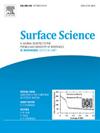Effect of biaxial strain on monolayer and defective SnSe2 systems: A first-principles study
IF 2.1
4区 化学
Q3 CHEMISTRY, PHYSICAL
引用次数: 0
Abstract
In this study, the structural stability, electronic structure, and optical properties of monolayer 2D material SnSe2 and Se vacancy defect systems under biaxial strain were investigated based on first-principle calculations. The findings showed that the structural stability of a single Se vacancy system is higher than that of a single Sn or two Se vacancy systems. In addition, phonon spectra and AIMD calculations verified the rationality and excellent dynamics stability of the SnSe2 structure. Electronic structure analysis showed that pristine monolayer SnSe2 is an indirect bandgap semiconductor with a bandgap of 0.851 eV. The vacancies of Se atoms make the SnSe2 system close to semi-metallic properties, significantly improving its conductivity. Under the compressive strain of 3%, the band gap type of the defect system is transformed. The optical properties showed that the peak of ε1(ω) and ε2(ω) for the pristine monolayer SnSe2 system produced a redshift under biaxial tensile strain. After the Se atom vacancy, the peak of ε1(ω) and ε2(ω) increased significantly. The absorption and reflection peaks of the pristine monolayer SnSe2 and Se vacancy systems were redshifted under the biaxial compressive strain and blue-shifted under the biaxial tensile strain. The combined action of defects and biaxial strain enhances light absorption in the infrared region and provides a powerful theoretical basis for exploring optoelectronics.

双轴应变对单层和缺陷SnSe2体系的影响:第一性原理研究
在本研究中,基于第一性原理计算研究了单层二维材料SnSe2和Se空位缺陷体系在双轴应变下的结构稳定性、电子结构和光学性质。结果表明,单个Se空位体系的结构稳定性高于单个Sn或两个Se空位体系。此外,声子谱和AIMD计算验证了SnSe2结构的合理性和良好的动力学稳定性。电子结构分析表明,原始单层SnSe2为间接带隙半导体,带隙为0.851 eV。Se原子的空位使得SnSe2体系接近半金属性质,显著提高了其导电性。在3%的压缩应变下,缺陷体系的带隙类型发生了转变。光学性质表明,原始单层SnSe2体系的ε1(ω)和ε2(ω)峰在双轴拉伸应变作用下产生红移。Se原子空位后,ε1(ω)和ε2(ω)的峰值显著升高。原始单层SnSe2和Se空位体系的吸收和反射峰在双轴压缩应变下发生红移,在双轴拉伸应变下发生蓝移。缺陷和双轴应变的共同作用增强了红外区的光吸收,为探索光电子学提供了有力的理论基础。
本文章由计算机程序翻译,如有差异,请以英文原文为准。
求助全文
约1分钟内获得全文
求助全文
来源期刊

Surface Science
化学-物理:凝聚态物理
CiteScore
3.30
自引率
5.30%
发文量
137
审稿时长
25 days
期刊介绍:
Surface Science is devoted to elucidating the fundamental aspects of chemistry and physics occurring at a wide range of surfaces and interfaces and to disseminating this knowledge fast. The journal welcomes a broad spectrum of topics, including but not limited to:
• model systems (e.g. in Ultra High Vacuum) under well-controlled reactive conditions
• nanoscale science and engineering, including manipulation of matter at the atomic/molecular scale and assembly phenomena
• reactivity of surfaces as related to various applied areas including heterogeneous catalysis, chemistry at electrified interfaces, and semiconductors functionalization
• phenomena at interfaces relevant to energy storage and conversion, and fuels production and utilization
• surface reactivity for environmental protection and pollution remediation
• interactions at surfaces of soft matter, including polymers and biomaterials.
Both experimental and theoretical work, including modeling, is within the scope of the journal. Work published in Surface Science reaches a wide readership, from chemistry and physics to biology and materials science and engineering, providing an excellent forum for cross-fertilization of ideas and broad dissemination of scientific discoveries.
 求助内容:
求助内容: 应助结果提醒方式:
应助结果提醒方式:


